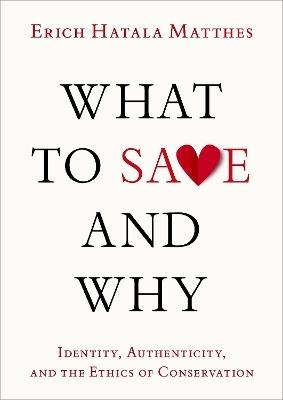
What to Save and Why
Oxford University Press Inc (Verlag)
978-0-19-774455-0 (ISBN)
- Lieferbar (Termin unbekannt)
- Portofrei ab CHF 40
- Auch auf Rechnung
- Artikel merken
A family heirloom. An endangered species. An ancient piece of pottery. A threatened language. These things differ in myriad ways, but they are tied together by a common thread: they are all examples of things that call out to be saved. The world is brimming with things worth saving, and we have limited time and resources. How do we decide what to save? Why do we make these choices?
Philosopher Erich Hatala Matthes explores these questions as they surface in radically diverse contexts--from museums to TikTok, and from National Parks to the corner of your attic. Matthes illustrates the deep relationship between the things we might save and our sense of self. If our cares and concerns are a fundamental part of our identity, then what we care for and preserve will play a significant role in shaping and maintaining our understanding of who we are. In a world in which everything that we care about is subject to powerful forces of change--from climate disturbance and armed conflict, to social transformation and the wear and tear of time--the terms on which we confront change will be key to whether and how we can save the things we care about in the ways that really matter to us. Will change be foisted upon us? Or is there a role for us to play in rejecting, influencing, or managing change? As he explores these questions, Matthes tackles related themes such as authenticity, agency, and appropriation: Who exactly should be responsible for saving things, and on whose behalf should such efforts be pursued? These are all essential elements to a fuller understanding of what to save and why.
Erich Hatala Matthes is Associate Professor of Philosophy and Advisory Faculty for Environmental Studies at Wellesley College, where he has taught for over a decade. His research and teaching focus on the ethics, politics, and aesthetics of art, cultural heritage, and the environment. He is author of Drawing the Line: What to Do with the Work of Immoral Artists from Museums to the Movies (OUP, 2022).
1. Introduction
2. From Heirlooms to Tacos: What Should We Save?
3. From Wilderness to Pottery: Why Should We Save Things?
4. From Climate Change to Colonialism: From What Should We Save Things?
5. From Language Revitalization to Digital Replication: How Should We Save Things?
6. From Appropriation to Participation: By Whom Should Things Be Saved?
7. From Ourselves to Future Generations: For Whom Should We Save Things?
Index
| Erscheinungsdatum | 05.09.2024 |
|---|---|
| Verlagsort | New York |
| Sprache | englisch |
| Maße | 137 x 185 mm |
| Gewicht | 318 g |
| Themenwelt | Kunst / Musik / Theater ► Kunstgeschichte / Kunststile |
| Geisteswissenschaften ► Philosophie ► Ethik | |
| Naturwissenschaften ► Biologie ► Ökologie / Naturschutz | |
| Technik ► Umwelttechnik / Biotechnologie | |
| ISBN-10 | 0-19-774455-9 / 0197744559 |
| ISBN-13 | 978-0-19-774455-0 / 9780197744550 |
| Zustand | Neuware |
| Haben Sie eine Frage zum Produkt? |
aus dem Bereich


